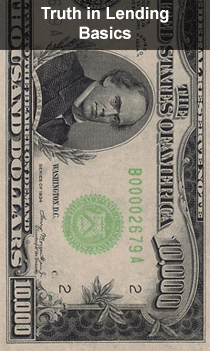 Truth in Lending was introduced in 1968 to ensure uniformity in the way that costs incurred in borrowing, such as a mortgage loan, are calculated and presented to the borrower. It should, in theory, enable consumers to compare the costs of various mortgage loan types and lenders in a consistent manner. Let’s take an example.
Truth in Lending was introduced in 1968 to ensure uniformity in the way that costs incurred in borrowing, such as a mortgage loan, are calculated and presented to the borrower. It should, in theory, enable consumers to compare the costs of various mortgage loan types and lenders in a consistent manner. Let’s take an example.
Mortgage Loan Information You Want
You apply for a mortgage for $250,000 over 30 years at a fixed interest rate – known as a fixed rate mortgage. The costs you want to know are:
- The fixed interest rate. Your monthly payment will be calculated from this rate and the principal repayment each month.
- The lender fees you must pay at closing. This must be paid in cash to the lender, so it is important that know exactly what this amount will be. Not only do you need to know the actual sum to be paid in cash so you have it available, but also what that is as a percentage of the loan amount. That enables you to judge whether or not it is worthwhile paying more of a down payment. On a $250,000 mortgage, every 0.1% lender fee is $250 dollars to be paid up front.
- The total interest costs over the term of the mortgage. This is important because it indicates how much you are paying that doesn’t involve repayment of your mortgage loan. You can then find the total cost of the mortgage to you by adding the upfront fees to that. In the final analysis, this is the best way of comparing the costs of various mortgage offers.
You compare fixed interest rates and upfront fees and then combine the two for a total mortgage cost. That’s fine for a fixed interest mortgage, but what about a variable rate or adjustable mortgage? This is more complex, although the same points being made here also apply to them.
Is Truth in Lending Effective?
These are the costs that are relevant and important to you. Does Truth in Lending provide these? Yes and no! You must understand the terms used and what charges are included under each term. Under Truth in Lending, you would be informed of:
- The APR (Annual Percentage Rate). This is based upon the interest you would pay over 30 years. If you expect your mortgage to last less than that, then this will be irrelevant.
- The total repayment, which is your monthly repayment times the number of months – in this case 360.
- The sum financed, which is the amount of your loan less the finance charges paid at closing.
- The total finance charge: This is the total of the finance charge you paid upfront (lender’s fee) and the total amount interest you pay over the 30 year period.
By comparing each of these figures, you can make a decision on which offer you prefer to accept. Some complain that Truth in Lending does not adequately cover situations where the mortgage is paid early – but how can it? How does a lender know that you will repay your mortgage loan in 10 years rather than 30 years unless you take it over 10 years?
The Truth in Lending Act obliges lenders to be truthful in the costs of your mortgage loan. They will make these calculations based upon the information you provide and on the agreed repayment period of your mortgage. In that respect, it is a huge improvement in consumer rights relative to the situation prior to it becoming law.



About The Author: Kenneth Le
More posts by Kenneth Le